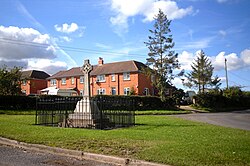Moreton, Oxfordshire
| Moreton | |
| Oxfordshire | |
|---|---|

| |
| Location | |
| Grid reference: | SP693042 |
| Location: | 51°43’57"N, 0°59’52"W |
| Data | |
| Post town: | Thame |
| Postcode: | OX9 |
| Dialling code: | 01844 |
| Local Government | |
| Council: | South Oxfordshire |
| Parliamentary constituency: |
Henley |
Moreton is a hamlet a mile south-west of Thame in Oxfordshire.
The hamlet is at the end of a single road; a spur off the A329., though two rough tracks, just passable, lead out to Tetsworth and to the Oxfordshire Golf Resort. These were once proper roads.
History
Moreton has been in existence as long as Thame, being mentioned with it in the Domesday Book of 1086.
Until well into the 18th century, the main thoroughfare from Aylesbury to Tetsworth (and on to Wallingford on Berkshire) ran through Moreton, which today is Moreton Lane in Thame. The needlemakers of Long Crendon made use of this road twice a year to send their goods by stagecoach for sale in London. It has been claimed that in the Civil War, Roundheads came down this road carrying the mortally wounded John Hampden from the Battle of Chalgrove Field to Thame in 1643.
In the past the main occupation of the inhabitants was farming — there being at least seven farms and more than 30 cottages, the majority housing the farm labourers. A decline in agriculture greatly reduced the size of the village and eventually led to the closure of the Methodist chapel, the school and the shop. The bottom of the decline came in the 1950s and today there are about 50 houses and cottages, plus two farms and a smallholding, all family-owned and run. The majority of Moreton’s older buildings cluster at the east end of the hamlet surrounding the green and the two ponds. They then trail thinly up to the war memorial which was erected in 1920. Beyond the war memorial is a small, but mixed, collection of houses.
Until early in the 20th century Moreton had two public houses: the Bell at one end and the Royal Oak at the other. Both have since closed and are now private houses.
References
- Oxfordshire Federation of Women's Institutes (1990). The New Oxfordshire Village Book. Villages of Britain. Countryside Books. ISBN 1-85306-090-9. https://archive.org/details/newoxfordshirevi0000unse.
